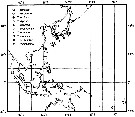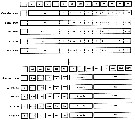|
|
 |
|
Calanoida ( Ordre ) |
|
|
|
Diaptomoidea ( Superfamille ) |
|
|
| |
| | | |
| Tortanidae Sars, 1902 ( Diaptomoidea ) | | Ref.: | Sars, 1902 (1903) (p.73); Gurney, 1931 a (p.215); Brodsky, 1950 (1967) (p.83, 428); Bowman & Abele, 1982 (p.9); Razouls, 1982 (p.622); Brodsky & al., 1983 (p.141, 145); Sazhina, 1985 (p.120); Mauchline, 1988 (p.717, 740: pores cuticulaires); Huys & Boxshall, 1991 (p.419); Zheng Zhong & al., 1984 (1989) (p.259, clé spp.); Chihara & Omori, 1997 (p.924); Barthélémy, 1999 a (p.24); Bradford-Grieve & al., 1999 (p.886, 901, 904, 963); Ohtsuka & Huys, 2001 (p.461); Boxshall & Halsey, 2004 (p.12; 49; 212, Def., Subgenera. key; p.214: Rem: this family placed by Andronov (1974) among Centropagoidea is transferred to the super-family Diaptomoidea. Blanco-Bercial & al., 2011 (p.103, Table 1, Fig.2, 3, 4, molecular biology, phylogeny); Laakmann & al., 2019 (p.330, fig. 2, 3, phylogenetic relationships)
Bradford-Grieve J.M., (2002 onwards). Key to calanoid copepod families. Version 1 : 2 oct 2002. http://www.crustacea.net/crustace/calanoida/index.htm  | | Rem.: | 1 G.: Tortanus. |  Issued from : G.A. Boxshall & S.H. Halsey in The Ray Society, 2004, No 166, Part. I. [p.214]. Key of subgenera. |
 Issued from : G.A. Boxshall & S.H. Halsey in An Introduction to Copepod Diversity.The Ray Society, 2004, No 166, Part. I. [p.212]. Armature formula of swimming legs P1 to P4. | | | | | (1) Tortanus Giesbrecht,1898; emend. Ohtsuka & Reid, 1998 | |
| | Syn.: | Corynura Brady, 1883 (p.70); Giesbrecht, 1892 (p.76, 525); Wheeler, 1901 (p.184) | | Ref.: | Giesbrecht & Schmeil, 1898 (p.157); van Breemen, 1908 a (p.162); A. Scott, 1909 (p.189); Esterly, 1924 (p.108); Steuer, 1926 (p.49, Rem.: 3 groups); Sewell, 1932 (p.398, Rem.: 2 Subgenera: Atortus and Tortanus); Wilson, 1932 a (p.166); Davis, 1949 (p.66); Mori, 1937 (1964) (p.105); Brodsky, 1950 (1967) (p.429); Tanaka, 1965 (p.395); Gonzalez & Bowman, 1965 (p.259); Bowman , 1971 b (p.521); Razouls, 1982 (p.622, Rem., concerning the Subgenus Atortus); Gardner & Szabo, 1982 (p.423); Othman, 1987 (p.71); Mauchline, 1988 (p.717: cuticular pores); Ohtsuka, Fukuura & Go, 1987 (p.58); Ohtsuka & Kimoto, 1989 (p.392, 405); Ferrari, 1992 (p.392, tab.3); Ohtsuka, 1992 a (p.255, 264, Rem : 4 Subgenera.); Razouls, 1993 (p.308); Chihara & Omori, 1997 (p.924); Mauchline, 1998 (p.97: F, M); Ohtsuka & Reid, 1998 (p.775, Rem.: 5 S.G., Subgenera Key); Bradford-Grieve, 1999 b (p.228, Def., Rem.); Boxshall & Halsey, 2004 (p.214, Subgenera Key); Mulyadi, 2004 (p.164, Def.) | | Rem.: | Type: Corynura gracilis Brady, 1883. 5 S.G.: Acutanus , Atortus, Boreotortanus, Eutortanus , Tortanus . Total: 47 spp. + 1 indet. | | Remarques sur les dimensions et le sex-ratio: | | The mean female size is 2.123 mm (n = 37; SD = 0.4937), and the mean male size is 1.789 mm (n = 37; SD = 0.4570). The size ratio (Male: Female) is 0.84 (n = 36; SD = 0.0848). The sex-ratio (Female: Male) is 1,03. |  ssued from : S. Nishida & N. Cho in Crustaceana, 2005, 78 (2). [p.232, Fig.4]. Occurrence records of the tropicus species complex (Othman, 1987) of the subgenus Atortus (modified from Ohtsuka & Kimoto, 1989). Localities and references: 1- Poseta Bay (Brodsky, 1950); 2- Sagami Bay (Tanaka, 1965); 3- Tanabe Bay (Ohtsuka & al., 1987); 4- Shijiki Bay (Ohtsuka & Kimoto, 1989); 5- Shibushi Bay (Ohtsuka & Kimoto, 1989); 6- Ryukyu Islands (Ohtsuka & Kimoto, 1989); 7- Pago Pago Harbor, American Samoa (Jones & Park, 1968); 8- Palau Tiga, Sabah (Othman, 1987); 9- Saleyer Anchorage (A. Scott, 1909); 10- Nankauri Harbor, Nicobar Islands (Sewell, 1932); 11- Hualien, Taiwan (Chen & Hwang, 1999); 12, Nha Rrang, Vietnam (Nishida & Cho, 2005). |
 Issued from : S. Ohtsuka & J.W. Reid in J. Crustacean Biol., 1998, 18 (4). [p.799, Fig.12]. Schematic illustration of fusion pattern and armature of female A1 of each subgenus of Tottanus. Roman and Arabic numerals indicate numbers of ancestral segments and of setae, respectively; ae = aesthetasc. Nota: Many transformations are found in rhe A1. The most primitive states of the segmentation and armature elements are exhibited by Boreotortanus. Reduction of elements is found in the ancestral segments X, XII, XIII, XIV, XV, XVII, XIX, XXI, and XXIV in the other subgenera. The fusion pattern and armature elements are the same in both the brevipes and recricauda complexes of Atottus. |
 Issued from : S. Ohtsuka & J.W. Reid in J. Crustacean Biol., 1998, 18 (4). [p.800, Fig.13]. Schematic illustration of fusion pattern and armature of right A1 of male of each subgenus of Tottanus. Roman and Arabic numerals indicate numbers of ancestral segments and of setae, respectively; ae = aesthetasc; p = process modified from element. Arrow indicates position of hinge. Nota: Right A1 as in the female, the most plesiomorphic states are retained by Boreotortanus. The other subgenera show reductions in the number of elements on the ancestral segments VI, VIII, X, XII, XIII, XIV, XV, XVII, XIX, XX, and XXIV. The fusion pattern and armature elements are the same in both the brevipes and recticauda complexes of Atortus as in female. |
 Issued from : S. Ohtsuka & J.W. Reid in J. Crustacean Biol., 1998, 18 (4). [p.801, Fig.14]. Maxillular (Mx1) praecoxal arthrite of Tortanus . Open circles indicates elements found in all subgenera of the genus Tortanus; closed square indicates that the subgenus Tortanus lacks this seta; closed circle indicates that the subgenera Boreotortanus and Acutanus lack this element in addition to the element symbolised by the closed square. Nota: Mx1 praecoxal arthrite shoxs different conditions. The most primitive state is retained by Eutortus and Atortus, with 13 elements in all. These elements are easily identified based on their relative size and position. The subgenus Tortanus lacks only one posterior seta, whereas both Boreotortabus and Acutanus lack 2 setae. |
 Issued from : S. Ohtsuka & J.W. Reid in J. Crustacean Biol., 1998, 18 (4). [p.803, Fig.15, A]. Phylogenetic relationship between subgenera of the genus Tortanus: A, cladogram, numbers refer to characters used in cladistic analysis for five subgenera of the genus Tortanus listed in Table 2 (p.798). |
 Issued from Bradford-Grieve inNIWA Biodiversity Memoir 111, 1999 [p.228]. Spine and setal formula for swimming legs P1 to P4. | | | | | Acutanus Ohtsuka, 1992 | | Ref.: | Ohtsuka, 1992 a (p.264, Def.); Ohtsuka & Reid, 1998 (p.775, 782, spp. Key); Boxshall & Halsey, 2004 (p.214) | | Rem.: | sp. type: Tortanus angularis Ohtsuka, 1992. Total: 4 spp. | | | | Atortus Ohtsuka, 1992 | | Ref.: | Sewell, 1932 (p.400); Bowman, 1971 a (p.521, 527: biogeography); Ohtsuka & Kimoto, 1989 (p.392, 404: biogeography); Ohtsuka, 1992 (p.265, Def.); Chihara & Omori, 1997 (p.925); Ohtsuka & Reid, 1998 (p.775, 786, spp. Key); Ohtsuka & Conway, 2003 (p.355, 358: Rem.); Boxshall & Halsey, 2004 (p.214); Nishida & Cho, 2005 (p.224, Rem.: p.229, geographic distribution, chart); Nishida & al., 2015 (p.224, Rem.); Mulyadi & al. (2017, p.97: Rem.: description of the co-occurence of 7 species of Tortanus (Atortus) in North Sulawest, Indonesia); Ohtsuka & Nishida, 2017 (p.575, Rem.); Brylinski & Courcot (2019, Rem.: p.365, coupling device); Francis & Bijoy Nandan, 2019 (p.433: Species key of the subgenus Atortus from the Indian Ocean) | | Rem.: | sp. type: Tortanus murrayi A. Scott, 1909. Total : 31 spp. | | | | Boreotortanus Ohtsuka & Reid, 1998 | | Ref.: | Ohtsuka & Reid, 1998 (p.775, 776, Def.); Boxshall & Halsey, 2004 (p.214) | | Rem.: | sp.type: Corynura discaudata | | | | Eutortanus Smirnov, 1935 | | Ref.: | Smirnov, 1935 (p.41); Ohtsuka, 1992 (p.263); Ohtsuka & al., 1992 (p.114, Def.,121: zoogeography, chart); Ohtsuka & al., 1995 (p.155: biogeography); Chihara & Omori, 1997 (p.924); Ohtsuka & Reid, 1998 (p.775, 787, emend., spp. Key); Itoh & al., 2001 (p.66, geographical distribution: fig.6); Boxshall & Halsey, 2004 (p.214); Ohtsuka & Nishida, 2017 (p.576) | | Rem.: | sp. type: Tortanus derjugini Smirnov, 1935. Total: 7 spp. | | | | Tortanus Giesbrecht & Schmeil, 1898 | | Syn.: | 'Groupe 2: gracilis-forcipatus-barbatus' Steuer,1926 (p.49) | | Ref.: | Bowman, 1971 a (p.521); Ohtsuka,1992 (p.264, Def.); Chihara & Omori, 1997 (p.924); Ohtsuka & Reid, 1998 (p.775, 781, spp. Key); Boxshall & Halsey, 2004 (p.214); Mulyadi, 2004 (p.164) | | Rem.: | sp. type: Corynura gracilis Brady, 1883. Total : 3 spp. | | | | |
|
|
 Toute utilisation de ce site pour une publication sera mentionnée avec la référence suivante : Toute utilisation de ce site pour une publication sera mentionnée avec la référence suivante :
Razouls C., Desreumaux N., Kouwenberg J. et de Bovée F., 2005-2025. - Biodiversité des Copépodes planctoniques marins (morphologie, répartition géographique et données biologiques). Sorbonne Université, CNRS. Disponible sur http://copepodes.obs-banyuls.fr [Accédé le 05 janvier 2026] © copyright 2005-2025 Sorbonne Université, CNRS
|
|
 |
 |








